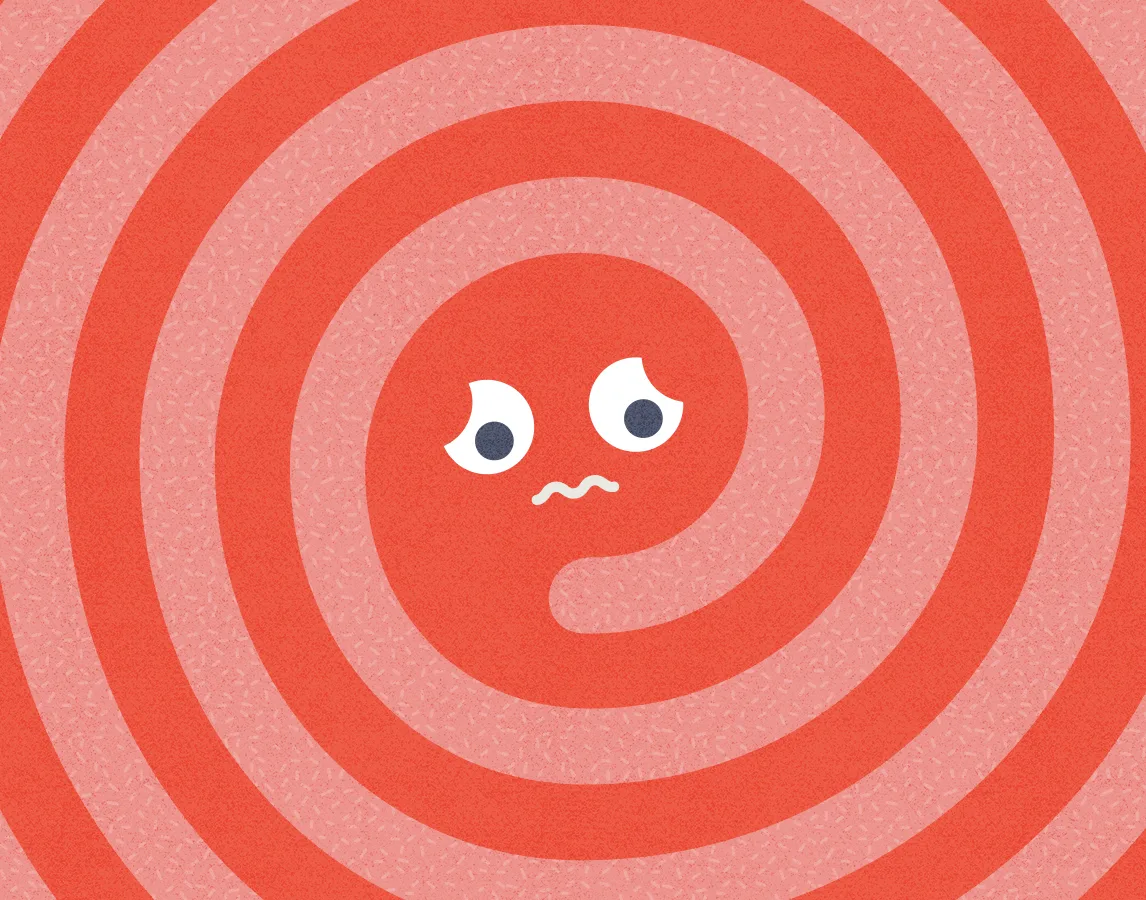4 things to remember the next time you’re spiraling
Robin G.
Jun 14, 2021
I notice a dark brown spot on my forehead. I lean closer to the mirror and examine it closely. It is dark in color, with irregular borders.
It’s melanoma, I’m thinking. As I brush my teeth, I imagine my final days. My friends visit, bring me flowers and sit by my bedside. My funeral takes place in a beautiful park by my house. People are huddled in small groups, speaking in hushed tones. What a shame, she was so young. I put away my toothbrush and my heart is flopping around like a fish on a pier. I reach up and touch the spot. And it rubs off. It was hair dye.
This is a habit of mine. When faced with the unknown, I expect the worst. And I can make mountains—no, volcanoes—out of molehills. Turns out, there’s a name for this: catastrophizing. This has become my new favorite word because it means I’m not the only one who does this. It also means I am likely not crazy. When we catastrophize, we actually do two things: first, we predict the worst possible outcome; second, we assume that if this outcome transpires, we won’t be able to cope and it will be an absolute disaster. We’ll fret over an exam, assuming that we will fail horribly and subsequently end up broke and destitute. We’ll decline an offer to go out on a date because we are sure the other person will find us unattractive and boring, and as a result, we’ll be single and desperately lonely until we die. Or, some of us see a spot on our face and automatically assume it is a terminal disease. (That said, if your new spot doesn’t rub off, calmly take yourself to the doctor to get it checked out.)

"Sometimes a molehill is really just a molehill."

Catastrophizing is incredibly common. Studies have shown that up to 70 percent of our thoughts are negative (this statistic is weirdly soothing—I thought it was just me). Don’t get me wrong, we don’t want to be this way; rather, our brains are hardwired to focus on the bad stuff. Once upon a time, this tendency was essential for survival. When venturing out of the safety of our caves to find food, we had to be constantly on the lookout for predators. Nowadays, our walk across the grocery store parking lot may not be as risky as a walk across the savannah, but thanks to evolution, our brains are still constantly on guard. But catastrophizing can lead to high levels of stress, anxiety, and depression. Interestingly, it can also make physical pain worse. In 1978, researchers John Chaves and Judith Brown asked dental patients to make note of the thoughts and images that came up in their minds during a stressful procedure. They found that patients that had negative thoughts suffered higher levels of pain—in addition to higher levels of stress—than those who did not. The problem isn’t so much the catastrophic thoughts themselves, but the fact that we tend to buy into them. We believe our own stories, and we ruminate when there is no actual threat present. In other words, we create our own suffering.
Now onto the good news: there are ways we can break out of this pattern of doom and gloom, and let go of our worst expectations. Next time you find yourself catastrophizing, try the following:
Recognize it
The first step is becoming aware of your own thought patterns. (A regular meditation practice for anxiety is wonderful for this.) Take it a step further and write down your worries throughout the day in a journal. Both of these activities allow you to step back and observe your own thoughts, rather than actively engaging with them. Eventually, you’ll see your worst-case scenarios for what they are: just thoughts, nothing more.
Ask questions
When you catch yourself predicting a terrible outcome, stop and ask yourself: “Is this something that I know to be true today? Is this outcome truly a catastrophe, or is it just unpleasant? What other possible outcomes are there? Are any of them positive?”
Have faith in your ability to cope
OK, so what if that Horrible Thing—bad date, failed test, illness—does happen? Think about how you would react and what you would do to make the outcome more positive. Reflect on past experience as well: how did you overcome past hardships? You’ll likely find comfort in knowing that you can, in fact, get through difficult times.
Be kind to yourself
Realize that this kind of thinking is natural, and something we all do from time to time. Don’t beat yourself up, and give yourself the space and the time to reflect and adjust. We won’t stop catastrophizing overnight—it is a process, one that can take place over a lifetime. Real life is nuanced; seldom do we experience true catastrophes. Even if we do, negative experiences are not always 100 percent horrible. The hardest, worst times in my life have contained moments of hope and even small flickers of joy. Our apocalyptic visions of the future do not take these details into account, and they make us fearful when there is nothing to fear. Sometimes a molehill is really just a molehill. And, I would argue, most of the time it’s not there at all. This piece was produced in partnership with Nike Training Club. To get started on your fitness journey, download the NTC app here.


Be kind to your mind
- Access the full library of 500+ meditations on everything from stress, to resilience, to compassion
- Put your mind to bed with sleep sounds, music, and wind-down exercises
- Make mindfulness a part of your daily routine with tension-releasing workouts, relaxing yoga, Focus music playlists, and more
Annual - billed at $69.99 USD/yr
14 days free
$5.83 USD/month
Monthly
7 days free
$12.99 USD/month

Meditation and mindfulness for any mind, any mood, any goal

Stay in the loop
Be the first to get updates on our latest content, special offers, and new features.
By signing up, you’re agreeing to receive marketing emails from Headspace. You can unsubscribe at any time. For more details, check out our Privacy Policy.
- © 2025 Headspace Inc.
- Terms & conditions
- Privacy policy
- Consumer Health Data
- Your privacy choices
- CA Privacy Notice







